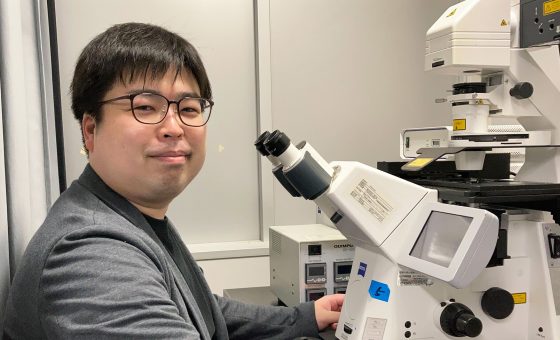Sensing cholesterol in cell membranes
Novel sensors indicate how cell functions are affected by the distribution of cholesterol across the cell membrane. This information could lead to new methods for cancer detection.

Cholesterol is an important component of the lipid bilayer that surrounds cells. Conventional imaging methods have not allowed researchers to determine the degree to which cholesterol is unevenly distributed on either side of the cell membrane. They have also failed to help researchers understand how changes in cholesterol distribution across the membrane affect cell functions.
Researchers at the University of Illinois at Chicago in the US, Kyung Hee University in Korea, and the Institute for Integrated Cell-Material Sciences (iCeMS) of Kyoto University in Japan have engineered novel cholesterol sensors.
The sensors were designed by isolating a unit, called the D4 domain, from the bacterial toxin perfringolysin O (PFO), which is known for its high specificity for cholesterol. The D4 domain on its own can only detect cholesterol in high concentrations. The researchers made changes to the D4 domains, making them more sensitive. These engineered domains were then labelled with one of two fluorescent chemicals. As such, the sensor was able to accurately determine cholesterol distribution on either side of the cell membrane at any point in time.
The team found that the amount of cholesterol on the inner side of the cell membrane was less than one-tenth of than its amount on its outer side. They also found evidence that this asymmetry is maintained by the active transport of cholesterol from the inner part of the membrane to its outer part. When the cell received a growth signal from a protein called Wnt, inner cholesterol increased with an equivalent decrease in outer cholesterol. These two factors—maintaining an asymmetry of cholesterol across the membrane and its stimulus-induced redistribution—are crucial for the fine-tuning of cellular processes, the researchers say.

Although a link between cholesterol and cancer has long been known, the mechanisms behind this link are poorly understood. The study found that some colorectal cancer cells with mutations in the Wnt signalling proteins had much higher cholesterol levels on the inside of the cell membrane than normal colorectal cells. The results imply that sensing the quantity of inner cholesterol could be used as a means to diagnose cancer.
“Our results provide a new conceptual basis and experimental tools for studying transbilayer dynamics, intracellular trafficking and regulatory function of cellular cholesterol and other lipids,” says Professor Kazumitsu Ueda of iCeMS, one of the study’s co-authors.
Publication information
"Orthogonal lipid sensors identify transbilayer asymmetry of plasma membrane cholesterol"
Shu-Lin Liu, Ren Sheng, Jae Hun Jung, Li Wang, Ewa Stec, Matthew J O'Connor, Seohyoen Song, Rama Kamesh Bikkavilli, Robert A Winn, Daesung Lee, Kwanghee Baek, Kazumitsu Ueda, Irena Leviatan, Kwang-Pyo Kim and Wonhwa Cho
Nature Chemical Biology | Published on 26 December 2016







